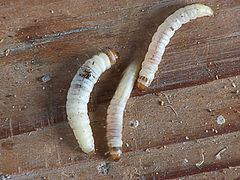Waxworms
| Waxworm | |
|---|---|
 |
|
| Achroia grisella caterpillars, length 13-16 mm. | |
| Scientific classification | |
| Kingdom: | Animalia |
| Phylum: | Arthropoda |
| Class: | Insecta |
| Order: | Lepidoptera |
| (unranked): | Obtectomera |
| Superfamily: | Pyraloidea |
| Family: |
Pyralidae Latreille, 1802 |
| Type species | |
|
Lesser wax moth (Achroia grisella) Greater wax moth (Galleria mellonella) |
|
Greater wax moth (Galleria mellonella)
Indian mealmoth (Plodia interpunctella)
Waxworms are the caterpillar larvae of wax moths, which belong to the family Pyralidae (snout moths). Two closely related species are commercially bred – the lesser wax moth (Achroia grisella) and the greater wax moth (Galleria mellonella). They belong to the tribe Galleriini in the snout moth subfamily Galleriinae. Another species whose larvae share that name is the Indian mealmoth (Plodia interpunctella), though this species is not available commercially.
The adult moths are sometimes called "bee moths", but, particularly in apiculture, this can also refer to Aphomia sociella, another Galleriinae moth which also produces waxworms, but is not commercially bred.
Waxworms are medium-white caterpillars with black-tipped feet and small, black or brown heads.
In the wild, they live as nest parasites in bee colonies and eat cocoons, pollen, and shed skins of bees, and chew through beeswax, thus the name. Beekeepers consider waxworms to be pests.Galleria mellonella (the greater wax moths) will not attack the bees directly, but feed on the wax used by the bees to build their honeycomb. Their full development to adults requires access to used brood comb or brood cell cleanings—these contain protein essential for the larvae's development, in the form of brood cocoons. The destruction of the comb will spill or contaminate stored honey and may kill bee larvae or be the cause of the spreading of honey bee diseases.
...
Wikipedia
